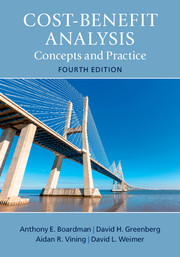Chapter 13 - Valuing Impacts from Observed Behavior: Direct Estimation of Demand Curves
from PART III - VALUATION OF IMPACTS
Summary
Akey concept for valuing policy impacts is change in social surplus. As discussed in Chapters 3 and 4, changes in social surplus are represented by areas, often as triangles or trapezoids, bounded by supply and demand curves. Measurement of changes in social surplus is relatively straightforward when we know the shapes (functional forms) and positions of the supply and demand curves in the relevant primary market, before and after the policy change. In practice, however, these curves are usually not known. Analysts have to estimate them or find alternative ways to measure benefits and costs. In the previous chapter, we discuss how such information can be gathered from demonstrations. In this chapter, we discuss direct estimation of these curves.
We focus on estimating demand curves because, in practice, analysts are more interested in estimating changes in consumer surplus than estimating changes in producer surplus. There are three main reasons. First, changes in producer surplus are often offset by changes in consumer surplus, and thereby constitute transfers. Second, they are often negligible. Third, for ex post CBA, changes in producer surplus can usually be computed more easily from changes in profits, which can often be obtained directly from affected firms. There are, however, two major situations when it is important to estimate the supply curve. One pertains to unemployed labor, which we discuss in detail in Chapters 4 and 12. The second arises when the government intervenes in otherwise efficient markets for capital, foreign exchange, labor, and other productive assets. We discuss these issues in Chapter 17.
For goods traded in well-functioning markets, we can usually observe the market clearing price. We may also observe the aggregate quantity bought and sold so that we have the point of intersection of the demand and supply curves. The task in this chapter is to estimate changes in social surplus where there is limited information. We consider three situations. First, we suppose that we have only one observation on the demand curve but previous research provides knowledge of its shape (functional form), and either its elasticity or slope. Second, we suppose that we have a few observations (points) on the demand curve. Third, we suppose that we have many observations of prices and quantities from different regions or from different time periods. In the first two situations we can make simple extrapolations.
- Type
- Chapter
- Information
- Cost-Benefit Analysis , pp. 320 - 340Publisher: Cambridge University PressPrint publication year: 2017



